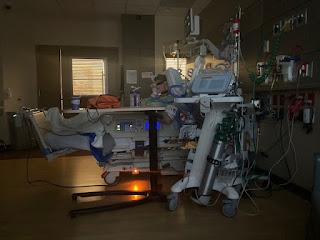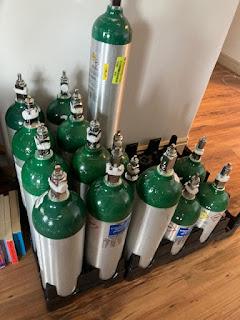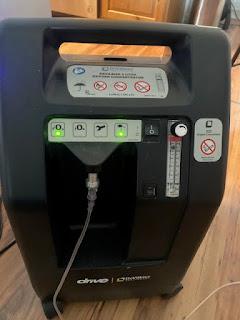
Michael in the ICU
February 2024
If you read the previous post, you know that my spouse was hospitalized for two weeks in early February of 2024 with a severe case of pneumonia. He spent eight of those days in the intensive care unit at Utah Valley Regional Medical Hospital. He was attached to a variety of machines at the time: some of them were monitoring his vitals (heart rate, blood pressure, oxygen saturation rate); some of them were giving him oxygen or fluids.
While in the hospital, he received supplemental oxygen via three devices:
- a BIPAP machine
- a CPAP machine
- a nasal cannula attached to an oxygen supply, such as a tank
When he was discharged, he started using oxygen via a fourth device:
- oxygen stationary concentrator
Although this is not a machine for delivering oxygen, we have two humidifiers running in our home to aid in Michael's breathing.
This post does not provide medical advice. It is merely to raise awareness. If you have any questions about your need for supplemental oxygen, please see a licensed medical professional.
I did not know much about any of these devices until he required them.
These are very technical, so I am chiefly going to provide links and videos so that the experts can explain them.
BIPAP Machines Work in Two Directions: Air In and Air Out
The acronym BIPAP stands for Bilevel Positive Airway Pressure. This is a machine that is less invasive than a ventilator but more invasive than a CPAP because it provides pressure not only with the inhale but also with an exhale.
Here is a 4-minute video that provides a more detailed, technical explanation.
CPAP Machines Work in One Direction: Forced Inhale Pressure
Once Michael was on antibiotics for a day or so, they switched him to a CPAP.
The acronym CPAP stands for continuous positive airway pressure. A CPAP can work with regular room air (that has about 20% oxygen), or it can include supplemental oxygen. When Michael was on a CPAP in the hospital, he had supplemental oxygen. He was also prescribed supplemental oxygen with the CPAP after discharge until he recovers fully.
Nasal Cannula with Tubing Connected to an Oxygen Tank

Once he was discharged, he got a tank in a little trolley and attached the nasal cannula and tubing to the oxygen tank.
Since then, he has received two smaller sized tanks, which allow him more mobility.
You can see the three sizes in the photo of his supply at home: tall, medium, and short.
He can put the medium and short tanks in a backpack designed for these tanks. This gives him easier of mobility.
Home health drops of new tanks and retrieves the empty tanks. Here is a short video that explains how to use the tanks.
Nasal Cannula and Tubing Connected to a Stationary Oxygen Concentrator
While Michael is at home, he is using an oxygen concentrator 24/7. He only uses a tank to go to a doctor's appointment. His oxygen falls too far if he exerts himself, so he is working from home for a few weeks.

Here is a 16-second video that illustrates how a concentrator works:
There are also portable oxygen concentrator, but his insurance has not approved him for using a portable one, so he has to lug around tanks for now if he leaves the house. But in February, he is not going anywhere except the doctor's office.
Related:
When Pneumonia Hijacked My Spouse

